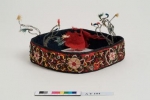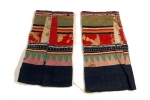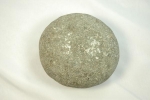|
Costumes of Taiwanese Aborigines –Decorations of the Upper Body |
|
Tags: aborigine | accessory | jewelry
 The aboriginal people in Taiwan have a great affection for body decorations, whether they are men or women. Decorations of the upper body include head accessories, earrings, necklaces, breast ornaments, armlets, bracelets, rings, etc. The materials used primarily contain jades, shells, animal teeth and bones, hide (or fur), precious metals (silver and bronze), buttons, coins, glass beads, and flowers and plants. These accessories fully represent the aesthetics and the value of these tribal cultures....
The aboriginal people in Taiwan have a great affection for body decorations, whether they are men or women. Decorations of the upper body include head accessories, earrings, necklaces, breast ornaments, armlets, bracelets, rings, etc. The materials used primarily contain jades, shells, animal teeth and bones, hide (or fur), precious metals (silver and bronze), buttons, coins, glass beads, and flowers and plants. These accessories fully represent the aesthetics and the value of these tribal cultures....
|
|
Read more...
|
|
The Clothing of Taiwan's Indigenous People – Clothing Accessories |
|
Tags: aborigine | accessory
 The clothing of Taiwan's indigenous people represents the prominent features of each tribe. It symbolizes cultural ideas and beliefs with vivid colors and diverse styles. Every indigenous tribe has its own unique clothing style and characteristics. Creatively, Paiwan, Rukai and Bunun peoples use dark blue or black cloth to present their lively and varied designs. Amis, Tsou, Saisiya, and Atayal peoples are apt to use blood red and azure (sky blue) to express their reverence and love for Nature. ....
The clothing of Taiwan's indigenous people represents the prominent features of each tribe. It symbolizes cultural ideas and beliefs with vivid colors and diverse styles. Every indigenous tribe has its own unique clothing style and characteristics. Creatively, Paiwan, Rukai and Bunun peoples use dark blue or black cloth to present their lively and varied designs. Amis, Tsou, Saisiya, and Atayal peoples are apt to use blood red and azure (sky blue) to express their reverence and love for Nature. ....
|
|
Read more...
|
|
An Easily Accessed Enjoyment in Life - Pottery Ornaments, Handicrafts, and Entertaining Toys |
|
Tags: aborigine | craft | pottery

By observing unearthed pottery from prehistoric sites, we can tell that the existence of pottery signifies human beings started to settle in more fixed places. ....
|
|
Read more...
|
|
Pottery Making Tools of Indigenous People in Taiwan |
|
Tags: aborigine | pottery

The wide use of pottery is the major characteristic of the Neolithic Age. Since pottery pieces account for the majority of the artifacts excavated, it is believed pottery was widely used in the Neolithic Age. Although the ways that pottery was made differ in each excavation site, pottery was an important tool.
The use of pottery in Taiwan dates back to Neolithic Age. The excavation of pottery vessels with rope pattering at the Dapenkeng Site and red pottery made of fine sand at the Puyuma Archeological Site indicates that there was wide use of pottery in prehistoric Taiwan. Pottery was used as tools or crafts and for entertainment, worshipping, and burial activities....
|
|
Read more...
|
|
"Below-Waist Accessories” for Taiwanese Aboriginal Clothing |
|
Tags: aborigine | accessory | clothing
 Below-waist accessories for Aboriginal clothing can be categorized into waist (hip) accessories and leg accessories. The waist accessories include belts, waist bands, waist bells, waist knifes and front covering cloth. Many aboriginal tribes in Taiwan did not wear pants; simply wrapping a piece of cloth around the waist and then having a front covering cloth. For the Saisiat Tribe, waist bells stand out amongst all waist accessories....
Below-waist accessories for Aboriginal clothing can be categorized into waist (hip) accessories and leg accessories. The waist accessories include belts, waist bands, waist bells, waist knifes and front covering cloth. Many aboriginal tribes in Taiwan did not wear pants; simply wrapping a piece of cloth around the waist and then having a front covering cloth. For the Saisiat Tribe, waist bells stand out amongst all waist accessories....
|
|
Read more...
|
|
|
Harmonious Interaction between Human Beings and Natural Environment—Offering Ceremonies |
|
Tags: aborigine | ceremony | culture
 Offering ceremonies display how people live and act according to the seasons of a year. These ceremonies also reveal the harmonious interaction between human beings and the natural environment. Aborigines, who traditionally subsisted on farming, fishing, and hunting, believed that the success of these activities relied on the blessings from spirits of gods and ancestors. Therefore, offering ceremonies were held to pray for these blessings.Offering ceremonies show the cultural essence of the beliefs, social organizations,.....
Offering ceremonies display how people live and act according to the seasons of a year. These ceremonies also reveal the harmonious interaction between human beings and the natural environment. Aborigines, who traditionally subsisted on farming, fishing, and hunting, believed that the success of these activities relied on the blessings from spirits of gods and ancestors. Therefore, offering ceremonies were held to pray for these blessings.Offering ceremonies show the cultural essence of the beliefs, social organizations,.....
|
|
Read more...
|
|
|
<< Start < Prev 11 12 13 14 15 16 17 Next > End >>
|
|
Page 16 of 17 |